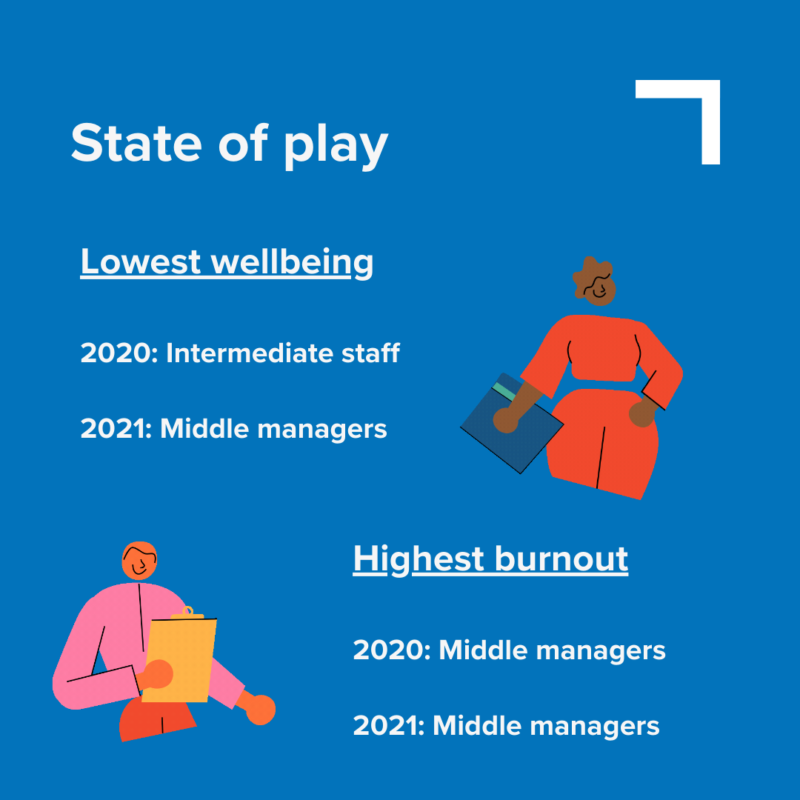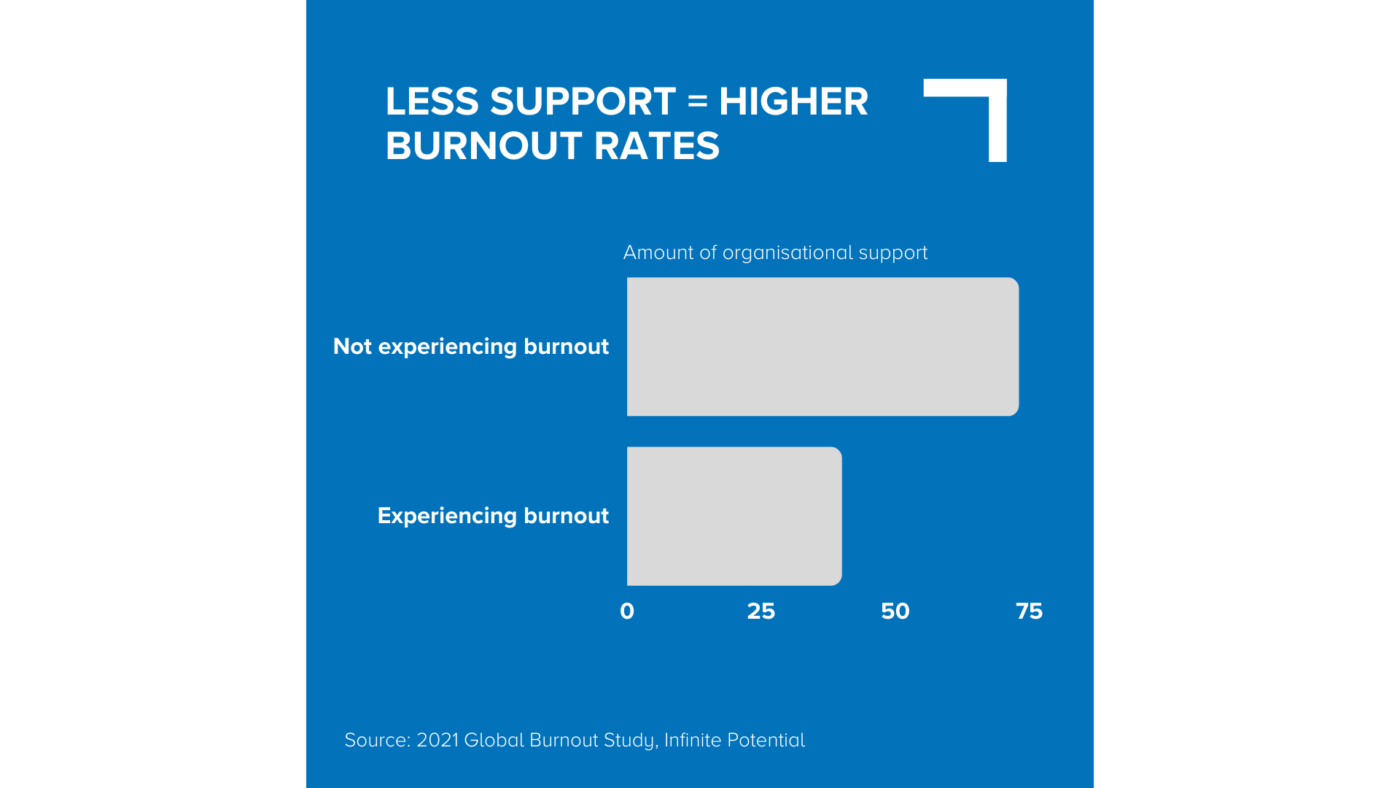Rising employee burnout at work stems from institutional rather than individual problems, a new report finds. And the pandemic hasn’t helped.
Last year did not bring the reprieve from workplace challenges that many hoped for. While we wanted to leave our burnt out brains in the past, it seems the universe had other plans.
From rising workloads to staff shortages, workforces continue to shift and respond to the latest challenges brought about by Omicron. As a result, burnout levels are going through the roof.
The 2021 Global Workplace Burnout Study, which includes insights from over 3000 participants across 30 countries, analysed global burnout trends facing organisations.
In 2020, the inaugural report established a baseline at the beginning of the pandemic and outlined the five organisational factors that were contributing to burnout at work. This year, it looks at burnout trends during year two of the pandemic, examines the barriers preventing leaders from inciting change, outlines which demographics are feeling it the most and unpacks the impact on productivity and work quality.
Head researcher of the report, industrial/organisational psychologist Dr John Chan speaks with HRM about his findings and offers some helpful solutions for HR professionals to put into practice.
Burnout on the rise
Burnout levels increased by 5 per cent compared to the previous year, with 34.7 per cent of respondents reporting feeling burnout, as defined by the World Health Organisation, the report finds. The study quotes data from the American Psychological Association which reveals that 63 per cent of burnt out employees were more likely to take a sick day, a statistic which Chan says is likely echoed in Australia. So this is a critical issue to stamp out.
A major conclusion from the 2021 study, which was co-authored by author and wellbeing coach Sally Clarke, is the need to understand burnout not as the fault of the individual but as the result of systemic issues across an organisation.
“The causes of burnout [are] very organisational and workplace specific,” says Chan. “Burnout occurs when an organisation’s culture or structure creates unmanageable stress for its people.”
According to the report, two major causes of workplace burnout are, at an individual level, a lack of manager support, unclear team communication and an unmanageable workload. At an organisational level, issues include: under-resourcing, resistance to new ways of working and a mismatch of values between employees and their company.
“Burnout occurs when an organisation’s culture or structure creates unmanageable stress for their people.” – Dr John Chan, industrial/organisational psychologist
Of course, the pandemic has enhanced many of these factors, says Chan.
“We can’t ignore the fact that the pandemic [has] had some effect on … how long we’re working, [and] the ways we’re working,” he says. “All of that is heightening the pressures that are leading to more and more burnout.”
The report suggests leaders consider the following questions when tackling burnout in their teams:
- How often do you talk to your team about their wellbeing?
- How do you ensure you limit the amount of ‘last-minute’ or ‘urgent’ work that comes through your team?
- Which actions could you take to foster stronger structural support for your team members?
Three dimensions of employee burnout
Burnout is more than just a feeling, says Chan.
“Asking people ‘How burnt out do you feel?’ is a common mistake employers make.”
For a more accurate perspective, there are three specific dimensions that should be used in measuring burnout.
“The way we define burnout is that [an employee] needs to be suffering from all three dimensions,” he says. “Those three dimensions are exhaustion, a growing cynicism for their job and reduced performance.”
The physical dimension is characterised by feeling exhausted and tired. Exhaustion can lead to changes in sleeping habits and temperament, which can affect productivity and an employee’s overall enthusiasm for work.
The second dimension, cynicism, leads burnt out employees to become disenfranchised with their work and team, and even develop negative and distrustful feelings.
“My hypothesis is that people are becoming more cynical in hearing what their organisations are saying versus actually doing,” says Chan. “During COVID, we’ve heard [employers say], ‘Our number one priority is protecting our people.’ But in action, some organisations might not have lived up to that.”
Thirdly, someone who is burnt out might experience a loss of professional efficacy, both at work and at home, finding it hard to concentrate. This impacts performance, creativity and cognitive function.
“From an organisational point of view, this is something that [leaders] really need to look at, because this is a major source of productivity [issues],” says Chan. “[It’s] also a quality of work problem. When burnout increases, the thing you see most is errors happening more and more.”
Questions for leaders:
- What are you doing to ensure your people are getting the rest they need to restore energy levels? (Read HRM’s article on the seven types of rest we all need, here).
- Do you role model good wellness behaviours and encourage others to do the same?
- Is the wellbeing of employees a consideration when budgeting?
How has employee wellbeing changed in 12 months?
Conducting a follow-up study one year after the initial study has enabled Chan to identify factors that have remained consistent, changed or decreased in prevalence.
Compared to 2020, burnt out employees in 2021 reported higher rates of diminished productivity and quality of work, particularly among middle managers. This category of workers had the highest level of burnout and the lowest level of wellbeing, according to the study.

Those experiencing burnout at work also reported a lower level of support from the organisation than those who did not.

These factors are compounded by ongoing social, professional and medical pressures relating to COVID-19, which has made many employees reconsider their commitments.
“You really reevaluate your life and the things you want to do,” says Chan. “[You might ask], ‘Do I want to put in 80 hours a week and miss out on things that I enjoy for this job?’ All of that has increased during these last couple of years.”
Some trends change and some stay the same, but one thing Chan is certain of is the pervasiveness of burnout.
“We can be sure that [rising burnout] will continue, even after the pandemic,” he says.
Questions for leaders:
- Are you assigning work and treating people in a respectful, equitable and fair way?
- Where is your organisation leaking energy in its work processes?
- Do you feel supported to push back on unreasonable demands from stakeholders?
Barriers to addressing burnout
A major barrier to eliminating burnout among employees is a resistance from management to face up to the issue. The study outlines four possible reasons for leaders holding back despite rising awareness of burnout. According to Chan, they are:
-
- Interpersonal risk. This is a major concern for leaders. Many fear they could come across as confrontational or ‘know-it-alls’ when taking a lead on addressing the underlying issues of burnout in their organisations, prompting them to hold off from making changes to the status quo.
- Cognitive dissonance. According to the study, many senior leaders have previously thrived in environments where burnout was the norm, prompting a cognitive dissonance whereby leaders retain existing structures because it worked well for them in the past.
- Fear of being blamed. Some leaders might worry they’ll cop a backlash for potentially not succeeding in eliminating burnout from their organisation, so they do nothing.
- Inertia. This relates to the layers of bureaucracy and process at many companies, which can mean inaction becomes institutionalised and perpetually unsolvable.
These barriers exist due to a lack of awareness, says Chan.
“I don’t think there is a clear understanding of what burnout is and what causes burnout among senior leaders,” he says.
“A lot of organisations and senior leaders still believe that this is a problem with the individual. If you look at a lot of the solutions they’ve come up with, it’s very individually focused. For example, providing a mental health day tasks the individual to rest so they can come back to the same stressful environment. We need to shift the focus to fixing that stressful environment.
“This won’t be an easy journey for senior leaders to rethink how work gets done in a way that doesn’t burn out their people and how to make it work in their organisations.”
Questions for leaders:
- What mindset do senior leaders have around change and adaptability?
- Are investors, C-suite and leaders aware of the powerful financial incentives for ensuring employee wellbeing?
- What impact would wiser investment of resources have for teams over the longer term?
Actionable tips to prevent burnout at work
The solution to employee burnout is to fundamentally redesign the way we work, says Chan.
The study outlines a four-step framework leaders can use to stop burnout in its tracks. Chan calls this the RISE model.
-
- Rethink established structures. “Addressing burnout requires a rethink of some of the fundamental assumptions and norms we have about work,” says Chan. “This can be difficult for many organisations as those fundamental assumptions and norms might be the reason they have been successful in the past.
- Inspire leaders to prioritise wellbeing. “Addressing an issue as large and complex as burnout … will require people with the courage, determination, and vision to realise the solutions that organisations need,” says Chan. “Leaders will need to be inspired to take on this role.”
- Support leaders through education, resources and acknowledgement. “Beyond the good intentions to address burnout, leaders must have a supportive infrastructure to help them translate the intent into action,” says Chan.
- Experiment with practical solutions to the problem. “All too often we are attached to [the idea that] ‘this is the way we do things’,” says Chan. “Combine that with an endless daily task list, there is little room for thought of experimentation. To find a solution, organisations need to create a culture that encourages cognitive diversity and learning from failure. This is a formula for creating an environment that will innovate solutions.”
“The point of the RISE framework is to create something where organisations can [look at] these four major areas [and ask], ‘How do we help our leaders rethink how we work?’”
The model enables leaders and HR to embed action on burnout across the organisation, creating a supportive system that relies on more than a short-lived wellness initiative or a company-wide week off.
“In the coming years, I believe this is going to be the biggest differentiator an organisation can make, to both retain and attract new talent.
“A few years ago, attractive organisations had nice offices [and] ping pong tables … but I think this next evolution of the employee value proposition is going to be all about taking care of your people. What does your organisation provide that shows you actually care?”
The question, therefore, becomes how far leaders are willing to go to support their workforce, foster a positive work environment, and boost both business productivity and employee satisfaction.
Questions for leaders:
- Do you create an environment to openly discuss burnout on a regular basis?
- How do you connect purpose with your people’s work?
Ensure your teams get the mental health support they need with this short course from AHRI. Sign up to the next session on 22 February 2022.


The headline underestimates the rise in burnout ~ and the situation is more dire . The report actually shows that 29.6% of workers were experiencing burnout in 2020 and this rose to 34.7% – an increase of 17.2%.
Fantastic article Lachlan. Very clear and well laid out – with practical suggestions.